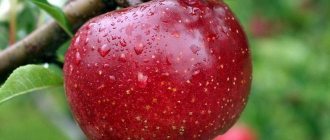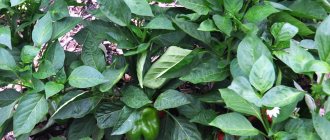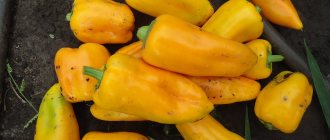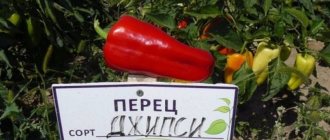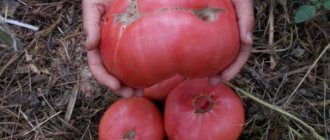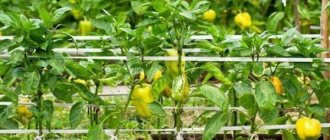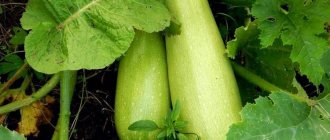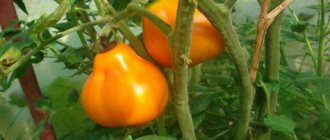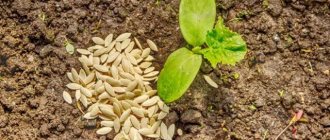Almost everyone grows sweet peppers in their own plots. This is an excellent vegetable crop for preparing for the winter and eating fresh. A good choice would be the Belozerka sweet pepper. This is confirmed by the characteristics, description of the variety, high yield, positive reviews.
Sweet bell peppers contain a lot of vitamins, and do not lose them when canned or frozen. That is why the vegetable is grown in large quantities in private plots.
Among the many varieties, sweet pepper “Belozerka” has a good characteristic; the description of the variety indicates high productivity; according to reviews from gardeners, the fruits have a pleasant taste. To successfully grow, you need to know all the features of this plant.
Description of the pepper variety
If we consider Belozerka sweet pepper for planting, the description of the variety is quite attractive. The fruits of the crop ripen quite early. In addition, the crop is easy to care for and undemanding to the composition of the soil.
Belozerka is characterized by the simultaneous appearance of ovaries and fruiting. This makes the crop in demand among farmers. Peppers can be stored for several months and can easily withstand transportation.
The bushes do not need shaping or staking. At the same time, they are decorated with lettuce, golden or red cone-shaped peppers. They can weigh 80-100 g - it all depends on the climate and the amount of watering. The pulp has a thickness of 0.5-0.7 cm, which is considered a good indicator.
Belozerka pepper: growing, planting and care
This variety of bell pepper should be planted in seedlings.
Seeds for further planting are usually purchased at garden stores.
Purchased seeds should be soaked in a growth stimulant solution before planting for germination and rapid germination.
Preparing soil and containers for planting
For growing Belozerka bell peppers, purchased soil for vegetable seedlings is quite suitable. It contains all the necessary fertilizers for the active growth of pepper seedlings.
But some vegetable growers prepare a nutrient mixture on their own; for this they mix leaf and turf soil, to which they add river sand and a little wood ash. Home-prepared soil must be spilled with a weak solution of potassium permanganate to disinfect it before placing it in containers.
Photo of preparing soil and containers for pepper seedlings
If the containers in which bell pepper seedlings will be grown have previously been used for growing plants, they should also be disinfected with potassium permanganate or Bordeaux mixture.
Then a nutrient substrate is poured into the containers, which is moistened with water, and then grooves are made in it 1 cm deep and at a distance of 3 cm from each other, the seeds are laid out in them, sprinkled with earth, covered with polyethylene and placed in a dark place with an air temperature not less than 23-24 degrees Celsius.
Belozerka pepper seeds are sown for seedlings in the last ten days of February.
Hot pepper - varieties for open ground! The best varieties of hot peppers for open ground and home cultivation
Caring for Belozerka pepper seedlings
After the first shoots appear (about 7-10 days after planting), the polyethylene is removed and the containers are moved to a bright place. For normal growth and development, seedlings require 12 hours of daylight; if there is not enough lighting, then phytolamps are placed next to the plants to provide additional illumination to the plants.
Seedlings should be watered 2-3 times a week; usually watering is done using a spray bottle. Water for irrigation should be settled and warm (room temperature).
INTERESTING ARTICLE:
Fertilizing pepper seedlings at home
When 2-3 true leaves appear on the seedlings, they should be picked into separate cups. 12-14 days after picking Belozerka peppers, you can begin feeding the plants with special fertilizers for seedlings of vegetable plants.
On a note!
During the period of growing bell pepper seedlings, they should be fed at least 2 times.
Approximately 12-14 days before transplanting seedlings to a permanent place, the hardening procedure of young plants should begin. To do this, they are taken out onto the balcony or loggia, gradually increasing the time they spend “outside”.
Transplanting pepper seedlings to a permanent place
When the first buds appear on the grown seedlings, it is time to plant them in a permanent place:
- Belozerka bell pepper seedlings are planted in greenhouses in the second ten days of May;
- Strong seedlings can be transplanted into garden beds at the end of May, when the threat of spring return frosts has passed.
The beds for this vegetable crop should be prepared in advance - cleared of remnants of vegetation, added organic matter and mineral fertilizers, dug up the soil and loosened it.
The distance between adjacent plants in rows should be 0.4 m, and the depth of the holes should be no more than 20 cm.
Place a little humus and wood ash on the bottom of each hole.
One plant at a time is placed in the prepared holes, sprinkled with soil and carefully compacted.
INTERESTING TO KNOW! The best varieties of sweet peppers for open ground
Appearance
Sweet pepper Belozerka has medium-sized semi-standard bushes 40-70 cm high. They are covered with oval bright green leaves, which are located on short petioles. White flowers are found on the stems near the leafy petioles.
The fruits are drooping and medium in size. Their length reaches 10-12 cm. Peppers have a smooth structure and a sharp top.
Note! At the stage of technical maturity, the fruits have a light cream color. Ripe peppers have a light red hue.
The variety is characterized by medium-sized bushes
Reviews from gardeners
I'll tell you what I remember. This year it didn’t work out for me - the seeds were old and didn’t germinate. In general, I planted the variety for a long time, and first I bought the seeds, and then my own. The variety has not changed. Low bush - 35–40 cm, conical, slightly elongated fruits. The color of even young peppercorns is quite light, white-green, and at technical ripeness it is completely white. And already mature - light red. Walls 6–8mm, tasty in salads, in preparations, and stuffed. I would give him a 5.
Ninulia, Nizhny Novgorod region
https://www.tomat-pomidor.com/forums/topic/1433-belozerka/
Early ripening period, manages to build up 2-3 waves. I pick the first peppers that are white-yellowish and already slightly sweet. Reliable, produces crops in any weather! Fragrant, more productive from its seeds.
Zulfiya, Ufa
https://www.tomat-pomidor.com/forums/topic/1433-belozerka/
I also like this variety for its unpretentiousness and productivity in any summer. Every year I always plant 8 bushes. The fruits from it are usually ready first, and the size for stuffing suits me.
amarant, Nizhny Novgorod
https://www.tomat-pomidor.com/forums/topic/1433-belozerka/
I didn’t like this variety... I like thick-walled and sweet juicy ones, I wasn’t impressed with this variety, I won’t plant any more.
orchid
https://www.tomat-pomidor.com/forums/topic/1433-belozerka/
The big advantage of Belozerka is that it is very, very reliable in terms of yield. A very reliable technical variety; in my conditions, none of the modern varieties gives such a guaranteed yield.
Read also: How to feed garlic planted before winter in the spring: what to water, fertilizers
SvetaR, Moscow region
https://www.tomat-pomidor.com/forums/topic/1433-belozerka/
The list of advantages of Belozerka pepper looks so impressive that there is hardly a gardener who will pass by it and not want to try the variety on his plot. Due to its reliability and unpretentiousness, excellent commercial qualities of the fruit, this pepper can definitely be recommended for cultivation both on private plots and on farm fields for commercial purposes.
Characteristics and features
The bushes of this variety are characterized by the following features:
- semi-standard and spreading structure;
- height 40-80 cm;
- a large amount of foliage;
- number of fruits - 5-10 pieces;
- white or green flowers;
- Fruit ripening period is 110-115 days before technical maturity and 140-145 days before biological maturity.
The fruits have the following characteristics:
- with technical ripeness it is yellow, with biological ripeness it is red;
- length 15 cm;
- correct cone shape;
- hollow structure;
- wall thickness 5-7 mm;
- juicy pulp;
- sweet taste with a slight pungency;
- long shelf life and good transportability.
At the stage of technical ripeness, the fruits have a yellowish tint; at biological ripeness, they are red.
Agrotechnics of cultivation and care
Belozerka pepper variety is grown through seedlings. The seeds are prepared before being sown in the ground. They are placed in a small container with clean water for 5 minutes. The floating empty seeds are removed, the rest are kept for 20 minutes in a pink solution of potassium permanganate. This will protect the plants from future infections. Next, the seeds are soaked in a solution of any growth stimulant for 12 hours and sowed without washing.
Sow peppers in individual pots, cups or cassettes to avoid picking in the future. The container is disinfected with potassium permanganate, allowed to dry and filled with soil mixture. A ready-made mixture for vegetable seedlings, which can be purchased at gardening stores, is ideal. You can also prepare the soil yourself from leaf soil, humus and sand and a small amount of peat.
The pots are filled with soil mixture, watered and seeds are sown in them to a depth of 1 cm, after which they are carefully sprinkled on top with a thin layer of soil and covered with a light film. Then they are placed in a warm and well-lit place
The entire time the seedlings are growing, the temperature in the room is maintained at least 23-27 ºC and 18-20 ºC at night. In this case, there should be no sharp changes, nor should it exceed its maximum value.
Lighting should also be sufficient. Pepper seedlings should be illuminated for at least 9-10 hours every day. Since Belozerka seeds are sown in February or March, the plants usually do not have enough natural light, they stretch out and become light green. To make up for the lack of light, seedlings are illuminated with lamps in the morning and evening.
Seedlings should be watered moderately, the soil should be only slightly moist. Excessive watering leads to the death of roots due to lack of oxygen, acidification of the soil and the appearance of diseases and pests. The temperature of the liquid must be at least 25 ºC - cold water cannot be used. You need to water at the root.
Fertilize the seedlings 2 times - after the plants throw out 2 leaves and 2 weeks after that. Use ready-made complex fertilizers, diluting them in the dose specified by the manufacturer. A week before planting in the garden, the peppers are hardened off.
Planting of seedlings is carried out when constant heat is established.
This is important, since spring frosts can destroy young plants. The planting location is chosen so that it is well lit by the sun.
The soil should be fertile, light and loose.
Peppers are planted at a distance of 40-50 cm from each other. The row spacing is made at 55-60 cm. The holes should be of such a depth that the plant along with a lump of earth can easily fit into them. A handful of humus and ash or fertilizers containing nitrogen and potassium are poured into each of them. Then pour in warm water. When it is absorbed, begin planting the seedlings. The pepper is buried up to the root neck; there is no need to go lower. It is sprinkled with earth on top and lightly compacted.
After planting in the ground, further care for Belozerka pepper consists of:
- watering;
- loosening;
- weeding;
- applying fertilizers;
- regular fruit collection.
Water the peppers with warm, chlorine-free water. It is advisable to do this in the evenings so that the plant roots can make full use of the moisture. The frequency of watering is adjusted depending on the condition of the soil. It should always be moderately moist
After each such watering, the soil is carefully loosened, trying not to touch the roots. At the same time, weeds that have begun to sprout are weeded out.
Peppers of this variety are fertilized 3 times per season:
- 2 weeks after planting in the beds;
- when the pepper starts to bloom;
- when it bears fruit.
Both organic and mineral fertilizers are used. For the first feeding, take fresh manure from any domestic animal or bird, dilute it in water in a concentration of 1 to 10 and 1 to 20. Each plant should have approximately 1 liter of solution. They also use saltpeter (10-15 g per bucket of water). For the 2nd and 3rd feeding, ash or phosphorus-potassium fertilizers are used.
Since pepper of this variety is a fairly powerful plant with a large number of fruits, the bushes are formed into 2 stems to distribute the load. Additionally, they can be tied to pegs. There is no need to treat against pests and diseases, as this pepper demonstrates excellent resistance to both.
Belozerka fruits begin to be collected as soon as they reach technical ripeness. If you need to get red peppers, then allow them to ripen completely on the bush
Pick off the fruits carefully so as not to break the branches. Collected peppers are sent for processing, sale or storage.
We recommend reading
How to properly shape peppers
What fertilizers to feed peppers after planting?
Features of planting pepper seedlings, cultivation and care
Features of planting pepper seedlings in the ground
Comparison with similar varieties
Similar varieties of pepper include the following:
- Ox's ear is considered a mid-season variety. Technical ripeness of the fruit occurs 97-99 days after the sprouts appear. The variety is considered high-yielding. However, it bears less fruit than Belozerka. From 1 square meter you can get up to 3 kg of peppers.
- Hercules - has an average ripening period. The fruits are large in size and reach a weight of 200 g. From 1 bush you can get up to 3 kg of harvest.
- Swallow - considered a mid-season variety. The bushes are distinguished by their standard shape. From 1 square meter of beds it is possible to obtain up to 5 kg of fruit. The fruits weigh 70-100 g and reach 10 cm in length.
Belozerka pepper is considered a popular crop that is grown by many gardeners. It is characterized by high yield parameters and low maintenance requirements. However, to obtain a large number of fruits, the bushes need to be watered, loosened and fed on time. Adequate protection against diseases and pests is of no small importance.
Growing Belozerka pepper
Before planting in open ground, seedlings are traditionally grown. Peppers approximately ripen approximately 4 months after germination. It is better to move seedlings to the garden towards the end of May, when sudden cold snaps or frosts are unlikely. It is possible to grow strong, healthy plants if you follow the recommendations of correct agricultural practices.
Purchasing and selecting high-quality planting material that meets shelf life plays an important role. Small, empty, spoiled seeds are discarded. Proper preparation involves a mandatory disinfection step in order to neutralize pathogens that live on the surface of the grains. For disinfection, use a solution of ordinary potassium permanganate: 1 g is thoroughly diluted in a liter of water, the seeds are dipped in a fabric bag for 10-15 minutes, do not overexpose. Afterwards rinsing is performed. It is not superfluous to soak in herbal remedies that stimulate the rapid growth of crops. Products must be diluted according to instructions.
For seedlings, prepare special pots with soil containing fertilizers; purchased soil mixture for peppers is perfect. You can make good soil yourself by mixing:
- humus (rotted compost) – 2 parts;
- peat – 2 parts;
- washed sand - 1 part.
Advice. Additional disinfection and prevention of fungal diseases can be easily achieved by steaming the soil.
Pour the soil mixture into each container 2 cm below the side and compact it a little. The swollen, hatched seeds are carefully laid out on the surface with tweezers, keeping a distance of at least 1.5 cm between them. Cover the top with a centimeter or slightly larger layer of earth and compact
Watering is carried out carefully, then the grains will not be washed out. The containers are placed in a well-lit place with an optimal temperature of 22-25°C
Pepper seedlings
The first shoots usually appear within a week
When watering, pay attention that excess water should not stagnate in the tray, otherwise the plant will move upward and become thin. Periodically, turn the pots with the other side facing the sun to prevent the pepper from growing at an angle.
Fertilizing with liquid fertilizers is very useful; ready-made products are suitable, for example, Agricola, Mortar. As they grow, weak units are discarded, healthy and strong ones can be planted in larger pots. Add to 10-12 liters of soil:
- double superphosphate - 1 tbsp. spoon;
- wood ash – 100 g;
- special ready-made fertilizer for peppers - according to the instructions.
Reviews from those who grew the Belozerka variety
“I’ve been growing Belozerka for a long time. The result is always excellent, even if the summer is rainy and there are few sunny days. The pepper ripens quickly, and it’s delicious even if you pick it while it’s still green, without waiting for it to turn red.”
Irina Alekseevna, Tula region:
“We grow sweet peppers all the time. “Belozerka” is liked for its unpretentiousness. Bell peppers are generally considered to be tricky to grow. But “Belozerka” is not picky about care. Our soil is fertile, so we even get by without fertilizing.”
“At our summer cottage, we plant sweet peppers in a greenhouse. Weather conditions do not allow planting in open ground; they will take a long time to grow. The Belozerka variety is very suitable for us. You don’t have to wait until the fruits ripen. We pick them when they are still light green, but have already become large. They already taste good. Some ripen to red color. A very good variety, we didn’t even know, but it turns out that it was bred back in the last century.”
Landing in the ground
The Belozerka pepper is transplanted into open ground when the weather is good. In central Russia this is approximately the end of May - beginning of June. The average daily temperature should be at least 18°C. Pepper does not like clay soil. Peat and humus must be added to the beds. Between the rows there should be at least 50 cm, between the holes - 40 cm. The depth of the holes should be such that the entire root system fits, and the neck is located at soil level. If desired, you can add phosphorus, nitrogen, and potassium to the well.
- Carefully remove the plant from the pot with a lump of earth.
- Place in a prepared and watered hole.
- Sprinkle with earth.
- Compact.
- Pour over warm, settled water.
Cleaning and storage
Fruit harvesting can be carried out both in a state of technical (when the fruits are green) and biological (when the pepper acquires a rich red color) ripeness. In the first case, the shelf life increases almost one and a half times. The second option is more suitable when the fruits will be immediately eaten.
Belozerka should be stored in a cool, dry place. It’s good if you have a cellar or pantry; if not, the bottom shelf of the refrigerator will do.
It is important! If you want to preserve the pepper longer, pick it with the stalk and be sure to carefully sort the fruit.
“Belozerka” can also be frozen. After this, it practically does not lose its taste and benefits and helps, even in harsh winter, to prepare nourishing, vitamin-rich dishes with a rich aroma.
Advantages and Disadvantages of Culture
Each variety has its own “pros” and “cons” that must be taken into account when choosing a suitable crop for cultivation.
Positive aspects of the Belozerka variety
- easy to grow;
- does not require much fertilizer;
- high productivity;
- long shelf life;
- it is resistant to diseases;
- tolerates transportation well.
This variety has no obvious disadvantages. Some summer residents in central Russia note that with sweet peppers there is a lot of hassle when germinating seeds and seedlings. But this is a southern crop; growing in the northern regions requires more effort.
Plant nutrition
For better development of the root system, increased yield, and plant strength, regular feeding is necessary;
- When the first three leaves of the seedlings appear, you need to add 5 g of potassium fertilizers and 15 g of superphosphate fertilizers per 5 liters of water.
- After 2 weeks, the second feeding is the same as the first time, but it is necessary to double the concentration of nutrients.
- When transferring seedlings into the soil, you can add Kornevin fertilizer to the hole for better plant survival.
- When the first flowers appear, fertilizers, such as ash, are also applied. For 1 sq. meter you need 2 cups of ash. At the same time, hilling and loosening of the earth is carried out.
